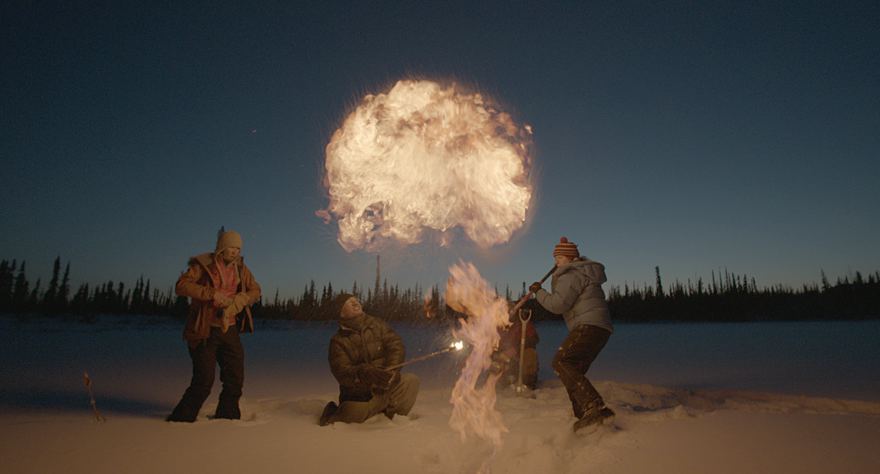
Succeeds on getting its message across with breathtaking visuals, but too many threads on a broad topic cools its effectiveness.

Succeeds on getting its message across with breathtaking visuals, but too many threads on a broad topic cools its effectiveness.
Former National Geographic contributor Louie Psihoyos made a name for himself as a filmmaker back in 2009 with his Oscar-winning dolphin fishing documentary The Cove. Psihoyos dives further into the water in his latest film Racing Extinction, this time focusing on whales, manta rays, and other animals that are nearing extinction. Using his extensive background in filming wildlife, Psihoyos captures stunning imagery from unique underwater photography and awe-inspiring time lapses to get his message across; mankind is destructive but also the solution.
Racing Extinction starts off with similar stealth tactics used in its predecessor, going undercover with hidden cameras to expose a restaurant illegally serving whale meat. But just as they’re served the forbidden dish, the scene ends. Turns out this opening bit actually back in 2010, ending abruptly with a news clip announcing that the restaurant got shut down from their discovery. Thankfully, there’s a much more thrilling (and longer) covert operation later when they reveal a shark fin processing plant. Watching the filmmakers sneak into this heavily guarded factory is a thrill ride. Especially when a hidden microphone becomes visible and nearly ruins the whole operation. The footage they end up getting of thousands of shark fins drying out on the rooftop is sickening and unforgettable. It’s this kind of guerilla filmmaking which made The Cove so gripping, so it’s unfortunate there wasn’t more of it here.
Alternately, the film shifts gears with a completely different topic (a frequent occurrence in this film). Our attention turns toward carbon dioxide emissions. Because the naked eye can’t see carbon dioxide the crew assembles a car with a fancy camera setup; one regular camera that captures what humans can see, and a special camera that uses a color filter to show carbon dioxide. When they take a spin down a busy street, their cameras detect an extraordinary amount of the greenhouse gas. But there is some irony in this. After all, they are emitting their own carbon dioxide by driving around to film. But Psihoyos intelligently points this out admitting, “The worst thing you can do for the environment is to make a film about it.” But perhaps leaving a carbon footprint and using large amounts of energy resources for creating a film about limiting them is a worthwhile trade-off to educate the public.
Visually speaking, Racing Extinction is an absolute delight. Far too often environmental documentaries result in data overload by stuffing itself with statistics and alarming information. But Psihoyos understands the best way to get a message across in our visual society is to display it. Beyond presenting some nifty infographics and animated sequences (a timeline of the earth represented as a 24-hour clock stands out), Psihoyos heads to the streets (again) to project informational video onto the Empire State building. It’s a brilliant and effective way to get information in front of crowds.
The biggest problem with Racing Extinction is that it tries to cover too much ground, casting a wide net around a range of topics such as our reliance on meat, shark fin soup popularity, emissions of carbon dioxide, underground methane gas, manta ray and whale hunting, and the decreasing plankton population. Because of that, the film feels sporadic. It jumps from one topic to the next often without enough time to develop a full story. Furthermore, nearly everything in the film has already taken place and has been widely reported by news outlets. This makes “the findings” a little less satisfying if you’ve been paying attention to news headlines and with each victory it feels like it’s giving itself a pat on the back.
Though the goal of Racing Extinction is to make the general population aware of the mass extinction going on right now—and for that reason the documentary largely succeeds. It makes very clear that we are our own worst enemy. Humans are to blame for the problems and we’re the ones who need to fix them.
But now that we know of all these problems then the question becomes, how do we prevent extinction? Throughout the film, I wondered if it was going to provide any solutions, or if were merely going to focus on the issues. It’s not until the ending credits that the film provides suggestions to these problems; we could stop buying endangered animal products, eat less meat, or install solar panels on our homes. Thankfully Racing Extinction knows doing all of them is simply not feasible, so it encourages viewers to pick one. The ball is in our court.